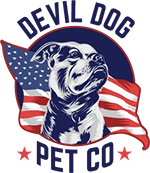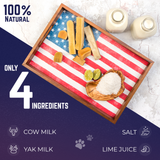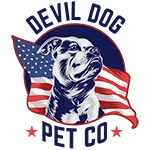Walk into any pet store and you'll find rows of pig ears stacked like golden promises of canine bliss. These chewy treats have become a go-to for dog owners seeking something tougher than a bully stick but softer than an antler. But here's the hard truth: pigs ears for dogs come with both benefits and serious risks that every responsible owner needs to understand before tossing one to their pup.
Key Takeaways
- Pig ears are popular chewy treats that offer a texture between bully sticks and antlers.
- These treats can provide enjoyable chewing experiences for dogs.
- There are important safety risks associated with pig ears that owners must be aware of.
- Responsible pet owners should understand both the benefits and dangers before giving pig ears to their dogs.
Table of Contents
At Devil Dog Pet Co., we've seen too many owners grab pig ears without knowing the full story. Some swear by them for dental health and joint support. Others have rushed to emergency vets after choking scares or bacterial infections. The difference? Knowledge and preparation.
Your dog's safety starts with your leadership—and that means making informed decisions about every treat that enters their mouth. Whether you're considering dog treats pigs ears for the first time or you've been serving them for years, this guide will arm you with the facts you need to protect your four-legged battle buddy.
Quick Answer
Pig ears can be safe dog treats when sourced from reputable suppliers, given in moderation, and under constant supervision. They offer protein, glucosamine, and dental benefits, but carry risks of bacterial contamination, choking, and digestive upset. Adult dogs handle them better than puppies, and quality matters more than price.
What Are Pig Ear Treats?
Pig ear treats are exactly what they sound like—the actual ears of pigs, processed into chewable treats for dogs. Made primarily from cartilage and skin (the pinna), these treats pack a protein punch that can reach up to 69% in some products. Unlike synthetic chews, pig ears are single-ingredient treats that dogs have been enjoying for decades.
The processing varies dramatically between suppliers. Some bulk pigs ears for dogs undergo minimal treatment—cleaned, dried, and packaged. Others get the full industrial treatment with smoking, chemical preservatives, and irradiation for shelf stability. This processing difference separates the premium products from the bargain-bin disasters.
What makes pig ears unique in the chew world is their texture. They're softer than rawhide but tougher than most meat treats, creating a sweet spot for dogs who need substantial chew time without risking tooth damage. The natural cartilage structure also provides glucosamine and chondroitin—compounds that support joint health, especially valuable for senior dogs or active breeds.
Pros
- High protein content (up to 69%)
- Natural source of glucosamine and chondroitin
- More digestible than rawhide
- Helps scrape plaque and tartar
- Provides mental stimulation
Cons
- Risk of bacterial contamination
- Choking hazard if swallowed in large pieces
- Can cause digestive upset
- Quality varies dramatically between suppliers
- Not suitable for puppies under 6 months
The best pigs ears for dogs come from pasture-raised pigs, undergo minimal processing, and arrive free from chemical additives. These premium options cost more upfront but deliver safer chewing experiences and better nutritional profiles. When you're comparing options, remember that the cheapest pig ear often carries the highest risk.
Here's where many owners go wrong: they assume all pig ears are created equal. A gas station pig ear treated with chemical preservatives and sourced from unknown facilities poses vastly different risks than a minimally processed ear from a traceable, ethical supplier. Your dog's safety depends on understanding these differences before you buy.
Potential Risks and Safety Concerns

Here's where pig ears get dangerous—and why your leadership as a dog owner matters more than marketing claims. Pigs ears for dogs carry legitimate risks that have sent countless pups to emergency vets. Understanding these hazards isn't fear-mongering; it's tactical preparation.
Bacterial Contamination Risk
The FDA has issued multiple warnings about pig ear treats contaminated with Salmonella, and for good reason. In 2019, a multi-state outbreak linked to pig ears sickened 154 people and countless dogs. The problem? Many suppliers skip proper sanitation protocols to cut costs, leaving dangerous pathogens on the final product.
Salmonella doesn't just threaten your dog—it spreads to humans through contact with contaminated treats, dog saliva, or surfaces. Puppies, senior dogs, and immune-compromised animals face the highest risk of severe illness. Symptoms include vomiting, diarrhea, fever, and lethargy that can escalate to life-threatening dehydration.
Critical Safety Fact: Even "processed" pig ears can harbor bacteria if sourcing and handling protocols fail. Always wash hands thoroughly after handling pig ears and clean any surfaces your dog contacts during chewing.
Choking and Obstruction Hazards
Pig ears become pliable as dogs chew, creating a perfect storm for choking incidents. Unlike antlers that wear down gradually, pig ears can break into large, soft chunks that lodge in the throat or intestinal tract. Emergency vets report regular cases of dogs requiring surgical removal of pig ear pieces.
The risk multiplies with aggressive chewers who attack treats like our dog Dexter used to—full throttle, no patience. These power chewers can reduce a pig ear to swallowable pieces in minutes, turning treat time into a medical emergency. Size matters too; a pig ear that's too small for your dog's mouth becomes a choking hazard immediately.
Digestive Upset and Complications
Rich, fatty pig ears can trigger pancreatitis in susceptible dogs, especially those with sensitive stomachs or previous digestive issues. The high fat content—while appealing to dogs—can overwhelm their digestive systems, leading to vomiting, diarrhea, and abdominal pain.
Even dogs with iron stomachs can experience issues if they consume too much too quickly. Large pieces that reach the intestines can cause blockages requiring emergency surgery. The softer texture that makes pig ears appealing also makes them more likely to form dangerous clumps in the digestive tract.
When Pig Ears Work
- Supervised chewing sessions only
- Adult dogs with healthy digestive systems
- Premium, properly sourced products
- Removed before becoming small enough to swallow
- Given occasionally, not daily
High-Risk Scenarios
- Unsupervised chewing sessions
- Puppies under 6 months old
- Dogs with sensitive stomachs
- Bargain-bin or unknown-source products
- Daily or frequent feeding
Chemical Processing Concerns
Many commercial pig ears undergo chemical treatments that create additional health risks. Preservatives, artificial colors, and smoking chemicals can trigger allergic reactions or long-term health issues. Some manufacturers use formaldehyde-based preservatives or irradiation processes that alter the nutritional profile.
The worst offenders are bulk pigs ears for dogs sold at discount retailers. These products often come from facilities with minimal oversight, using whatever chemicals necessary to achieve shelf stability and visual appeal. Your dog's health isn't worth saving a few dollars on treats.
Feeding Guidelines and Safety Tips
If you decide pig ears fit your dog's profile, here's how to minimize risks and maximize benefits. These aren't suggestions—they're non-negotiable safety protocols that separate responsible owners from those who learn the hard way.
Supervision and Monitoring Protocols
Never leave your dog alone with a pig ear. Period. Set a timer for 15-20 minutes maximum for first-time users, watching for signs of aggressive chewing, gagging, or attempts to swallow large pieces. Position yourself where you can intervene immediately if problems arise.
Watch your dog's chewing style closely. Side-gnawers who work the ear methodically pose lower risk than straight-down chompers who attack treats like prey. If your dog tries to swallow pieces larger than a marble, remove the ear immediately and consider switching to a more durable alternative.
Emergency Action Plan: If your dog starts choking on a pig ear piece, open their mouth and try to remove the obstruction with your fingers or pliers. If unsuccessful, perform the canine Heimlich maneuver and head to the nearest emergency vet immediately.
Portion and Frequency Guidelines
Treat pig ears as occasional rewards, not daily staples. Factor the calories into your dog's daily intake—a single pig ear can contain 200-300 calories, representing 20-30% of a medium dog's daily needs. This isn't a snack; it's a meal replacement that requires dietary adjustment.
Start with quarter-sessions for new users. Give your dog 5-10 minutes with the ear, then remove it and store for later. This approach lets you gauge their reaction while preventing overconsumption. Gradually increase time as you confirm their tolerance and chewing behavior.
Quality dog treats pigs ears should be given no more than 2-3 times per week for healthy adult dogs. Dogs with sensitive stomachs, seniors, or those prone to pancreatitis should receive them even less frequently—if at all. When in doubt, consult your veterinarian before introducing any new treat.
Safer Alternatives to Pig Ears

Smart dog owners don't settle for risky treats when superior alternatives exist. After years of testing chews with our dog Dexter and countless customer dogs, we've identified options that deliver the same satisfaction without the hazards. These alternatives offer better safety profiles, longer-lasting entertainment, and superior nutritional value.
Elk Antler Chews - Maximum Durability
Naturally shed elk antlers represent the gold standard for power chewers seeking long-term engagement. Unlike pig ears that soften and break apart, antlers maintain their structure throughout the chewing process, eliminating choking and obstruction risks. A single Medium elk antler can provide weeks of entertainment compared to a pig ear's 20-30 minutes.
Antlers contain zero bacteria risk since they're biologically inert bone tissue. The mineral-rich composition delivers calcium, phosphorus, and zinc without the fat content that triggers pancreatitis. For dogs transitioning from pig ears, start with split antlers that expose tasty marrow while maintaining safety.
Himalayan Yak Chews - Digestible Satisfaction
Yak cheese chews offer the perfect middle ground between pig ear appeal and antler durability. These lactose-free treats soften gradually as dogs chew, preventing the sudden breakage that makes pig ears dangerous. The fully digestible composition means swallowed pieces pass safely through the digestive system.
Traditional Himalayan processing creates a treat that's harder than pig ears but gentler than antlers, making them ideal for dogs with sensitive teeth or those recovering from dental work. The rich protein content satisfies the same cravings that draw dogs to pig ears without the bacterial contamination risk.
Premium Bully Sticks - Protein-Rich Safety
Single-ingredient bully sticks provide the meaty satisfaction dogs crave from pig ears while maintaining complete digestibility. Quality bully sticks from grass-fed cattle undergo rigorous processing that eliminates pathogen risks while preserving nutritional value. The fibrous texture promotes dental health through natural scraping action.
Unlike pig ears that can cause sudden digestive upset, properly sized bully sticks break down predictably in the digestive tract. Choose thick, braided varieties for power chewers or standard sizes for moderate gnawers. Always supervise and remove the final nub to prevent choking.
Why These Alternatives Win
- Predictable wear patterns prevent sudden breakage
- Rigorous processing eliminates bacterial contamination
- Longer-lasting value reduces per-session costs
- Nutritional benefits without pancreatitis risk
- Suitable for supervised long-term chewing
Pig Ear Disadvantages
- Unpredictable breakage creates choking hazards
- High bacterial contamination risk
- Short lifespan increases long-term costs
- Fat content triggers digestive issues
- Requires constant supervision due to safety risks
Making the Right Choice for Your Dog
The decision between pig ears and safer alternatives comes down to risk tolerance and leadership philosophy. Pigs ears for dogs can work for some owners willing to accept elevated risks, but they're never the optimal choice when superior options exist.
Risk Assessment Framework
Evaluate your dog's profile against these critical factors before choosing any chew. High-risk dogs include puppies under 12 months, seniors with compromised immune systems, dogs with previous digestive issues, and aggressive chewers who attack treats destructively. These animals should never receive pig ears regardless of quality or supervision level.
Medium-risk dogs include healthy adults with sensitive stomachs, moderate chewers who occasionally gulp treats, and dogs with food allergies or intolerances. These animals might handle premium pig ears with intensive supervision, but safer alternatives offer better risk-reward ratios.
Low-risk candidates are healthy adult dogs with strong digestive systems, methodical chewing styles, and no history of treat-related incidents. Even these dogs benefit from alternatives that provide longer-lasting entertainment without constant vigilance requirements.
Cost-Benefit Analysis
Premium pig ears cost $2-4 each and last 20-30 minutes, creating a cost-per-hour that exceeds most alternatives. A $8 elk antler providing 20+ hours of entertainment delivers superior value while eliminating safety risks. Factor in potential veterinary costs from pig ear incidents, and the economic argument becomes overwhelming.
The best pigs ears for dogs require constant supervision, limiting their usefulness for busy owners who need reliable long-term entertainment. Antlers and yak chews can safely occupy dogs for extended periods, providing real-world convenience that pig ears can't match.
Bottom Line: Every minute spent supervising pig ear chewing is a minute that could be invested in training, exercise, or bonding activities that strengthen your leadership relationship and improve your dog's overall well-being.
The Final Verdict

After examining the evidence, pig ears represent an unnecessary risk in a market filled with superior alternatives. While they're not universally dangerous, the combination of bacterial contamination risk, choking hazards, and digestive complications makes them a poor choice for responsible dog owners.
The dog treats pigs ears industry continues marketing these products despite well-documented risks because they're profitable and appealing to dogs. Don't let marketing claims override your judgment as a leader. Your dog deserves treats that provide long-term satisfaction without compromising their health or your peace of mind.
Choose elk antlers for maximum durability, yak chews for digestible satisfaction, or premium bully sticks for protein-rich entertainment. These alternatives cost less per hour of use, require less supervision, and eliminate the bacterial and choking risks that make pig ears problematic.
Your dog's safety isn't negotiable. When superior alternatives exist, choosing pig ears represents a failure of leadership that puts convenience above responsibility. Make the call that protects your teammate for the long haul—they're counting on you to choose wisely. For more on safe, healthy treat options, check out our comprehensive guide to healthy snacking.
Download the FREE 10-Step Dog Prep Guide
Frequently Asked Questions
Are pig ears safe for dogs?
Pig ears can be safe for many dogs when given occasionally and under supervision, but they carry risks like bacterial contamination and variability in quality. Always source from reputable suppliers and monitor your dog during chewing to prevent choking or digestive upset.
What is the problem with pig ears for dogs?
The main issues with pig ears are inconsistent sourcing and processing standards, which can lead to contamination with bacteria like Salmonella. They also tend to be high in fat and calories, can cause digestive upset, and pose choking or blockage risks if chewed into large pieces.
Are pig ears better than rawhide?
Pig ears offer a more natural texture and flavor compared to rawhide and tend to be more digestible, but they still carry risks of bacterial contamination and can be high in fat. Rawhide often involves chemical processing and is less digestible, so neither is perfect; safer, ethically sourced options with transparent processing are preferred.
How digestible are pig ears for dogs?
Pig ears are moderately digestible since they are natural animal tissue, but their high fat content and tough texture can make digestion slower and more challenging for some dogs, especially small or sensitive ones. Proper sizing and supervised chewing reduce digestive risks.
Can pig ears cause blockage in dogs?
Yes, pig ears can cause intestinal blockage if dogs swallow large chunks or if the ear is chewed into sharp pieces that don't pass easily. This risk is higher in aggressive chewers or dogs prone to gulping treats without thorough chewing.
What is an alternative to pig ears for dogs?
Durable, ethically sourced chews like whole elk antlers, Himalayan yak cheese chews, or USDA-approved bully sticks provide safer, nutrient-rich alternatives. These options offer mental stimulation and dental benefits with lower contamination risk and better digestibility when sized properly and used with supervision.






